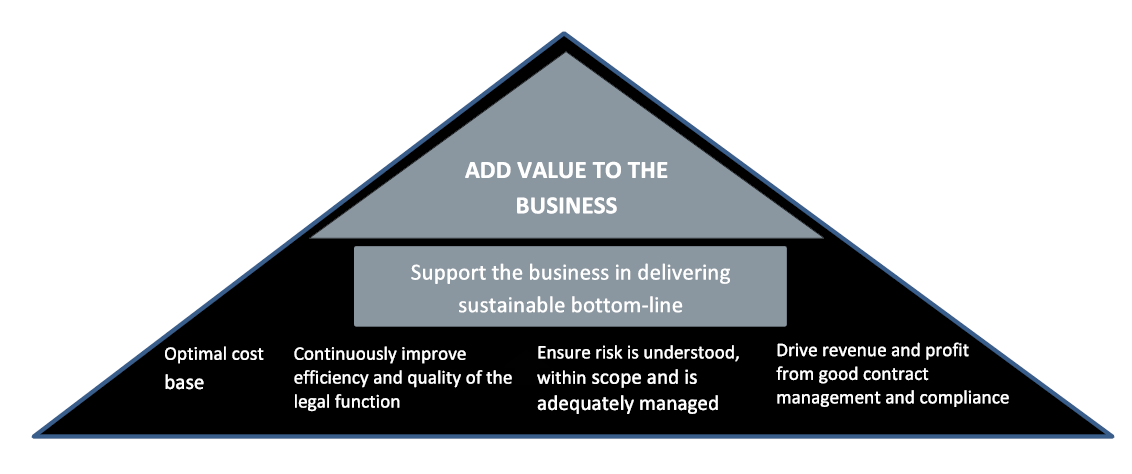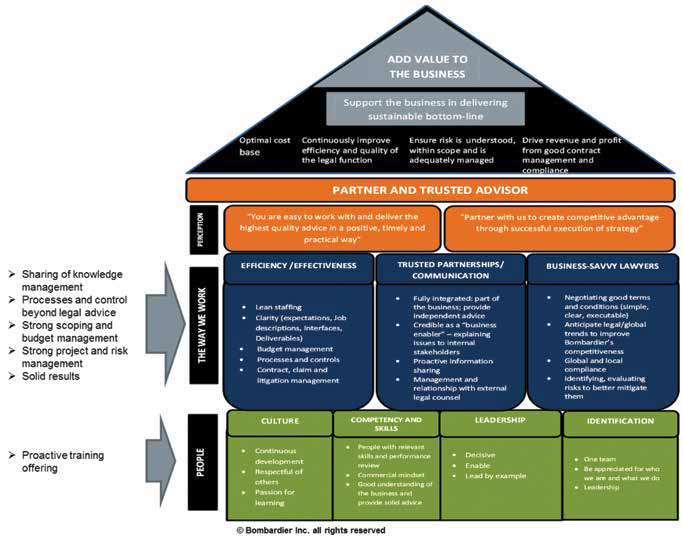
CHEAT SHEET
- Measuring value. Asking outside counsel to bring value to your organization first requires assessing how the legal department itself drives value.
- A disconnect in thinking. Law firms still largely rely on hours and dollars billed to assess value, even if alternative billing methods are coming to the fore.
- Growing the pyramid. The core pillars of value are a results-driven culture, basic competence, leadership, and identification as a global team.
- Assuming a role. Law firms can drive the education of law departments by developing long-term structured education programs which have a lengthy payoff.
Today, more than ever, corporate law departments are focusing on the notion of what constitutes “value” and how to enhance it to support their organizations. Not surprisingly, law firms are also increasingly focused on creating “value” for their clients as well. While both say “value” is their prime objective, the definitions differ.
These ongoing discussions about value have transcended the theoretical — there is now an exciting and mutually beneficial opportunity to forge new connections and partnerships in the law department/law firm relationship.
In defining the notion of value, there can often be a major disconnect between law firms and law departments, primarily based on the way that value is measured.
The law department value pyramid
As we all know, law departments will continue to radically transform. They have expanded in both role and stature within their organizations. Given the regulatory changes over the past 15 years, boards now increasingly rely on the in-house law department to take a lead role in all complex matters. As such, general counsel and their teams are reviewing, revising, and exploring ways to enhance the value we bring to the business units they support.
For us, the key question is: “How can we, as trusted advisors and business savvy lawyers, provide even more value to our business?”
To answer this question, the law department at Bombardier set out to map the responsibilities and deliverables that are core to the business units we support, which led to the creation of the pyramid chart. Our vision in taking this approach was to determine where to focus our efforts to have the greatest positive impact on the corporation.
We approached the creation of a pyramid “unique” to our company as a team exercise, with input and feedback from our in-house lawyers and our business colleagues in multiple jurisdictions. Ultimately, our goal is for the entire law department to align as a team and show what we will do, and just as importantly, what we will not do.
To start the discussion, we began by considering how we measure value. Only once we had a clear understanding of our own role and responsibilities within the business units, we broadened the discussion to address the value of our regularly used law firms.
Therefore, if the general counsel and law department are not clear about how we bring value to our organizations, then how can we expect to be clear with external law firms about how they can team with us? How can we expect law firms to bring better value to our law departments if they do not know our definition of value and only see part of our process?
It’s imperative that we better explain to law firms how we work internally, what our goals are, what makes us tick as an in-house law department, and most importantly, how we bring value to our company.
If we can articulate this with clarity, then our external law firms can understand where they can better add additional value, where there can be a better connection to us, as well as how they can support us better in multiple areas.
So before we can embark on any such discussion with our external law firms, we need to fully explore and then articulate how we as a law department bring value to our corporation. Hence, our pyramid.
Disconnect in measuring value
In defining the notion of value, there can often be a major disconnect between law firms and law departments, primarily based on the way that value is measured.
At Bombardier, for example, as we went through our pyramid exercise, we measured the quality of the services we provide and where we bring value to our corporation. In our case, the key indicators in assessing value are based on metrics tied to the nature of our businesses and responsibilities to our internal business units.
But how do law firms measure the value they bring to the client relationship from their side?
In contrast to law departments, law firms usually rely on a very different set of metrics, primarily based on hours and dollars billed. The underlying management assumption within a law firm is that if the hours billed and fees are high, a lot of value must have been created for the client. To be fair, a number of law firms are open to alternative billing methods. Still, the key value indicators for most law firms remains the number of hours billed.

As a measurement of the law firm’s commercial success, these metrics have a lot of merit. Yet a measure of value created for the client, this tool has the potential to be systemically faulty: Billings do not automatically mean value. As seen from the perspective of the law department, value may or may not have been achieved and increased legal costs for a law department never equates to a “good year” from a budget management perspective. Therein lies the disconnect.
Essential “value” pillars
Law departments add value to their corporations through supporting the business by delivering both a sustainable bottom line, developing creative legal strategies to ensure solid risk management and drive revenue and profit.
Whether a company is business-to-business or business-to-consumer, or a combination, and regardless of whether its scope is international or domestic, the essential concepts that bring sustainable and transactional value to the law department are identical.
To accomplish this, law departments must:
- Ensure an optimal cost base;
- Continuously improve the efficiency and quality of the legal function;
- Ensure risk is understood, within scope, and is adequately managed; and
- Assist the company in driving revenue and profit through the use of good contracts and claims management and compliance.
- Develop creative legal strategies to advance the business or improve its competitive position
The foundations of value
In order to achieve its objectives and meet its key performance indicators, it’s critical to equip the legal team with the skills and self-confidence to be regarded as trusted advisors and business savvy lawyers whom the business units wish to consult. The table below shows how culture, competencies, leadership, and identification are brought together through the engagement of law department personnel.

When we built our pyramid at Bombardier, as a team we decided the core pillars for us are:
- Culture of a results-driven team;
- Competency and skills;
- Leadership; and
- Identification as a global team.
As general counsel, if we want a team that is engaged and shows leadership, the team obviously must be skilled. Yet to “drive” skill we must foster a culture of continuous development and learning that takes into account all aspects that are integral to the business, its strategies, and risk management. It is not enough to focus solely on legal education.
Further, there must be a process whereby lawyers are clear as to their level of authority, so they can be decisive and enabled as leaders. There must also be a strong performance review process. At Bombardier we meet twice a year to do a formal performance review with objectives, which also includes each lawyer’s own continuous development and learning.
Is there a definable role for law firms in driving the education of law departments?
One way in which law firms can connect to us that brings value to our legal team, and allows us to deliver a better performance to our business, is through the continuous legal education and development they can offer.
Law firms are very well equipped to provide continuous learning on a great variety of meaningful topics that can be adapted to the needs of individual law departments.
As an example, consider data privacy. Increasingly, there’s a need to share personnel information across borders. Routinely, in this age, employees move between offices for a varied number of reasons. High-potential employees gain or share expertise, either for succession planning or many other reasons. Yet this mobility presents a very real danger of breaching data privacy laws, often due to conflicting regulations around the world. As a law department, we spend significant effort in place processes and controls to make sure that we do all of this in a compliant way.

So imagine the value a law firm will bring to its key clients through training in relevant compliance matters by way of structured educational programs over the long term. The way we see it, this is an opportunity most law firms do not capture; most often they offer ad hoc training. Yet the law firm that really supports a law department and invests in that relationship creates a bridge that forms the collaboration between both.
From the law department perspective, being better-trained lawyers with more skills lets us show more leadership within our organizations, and become, or remain, the trusted partners to our business units that all law department lawyers strive to be.

The drive for efficiency
As a law department team, we have to drive our own efficiency. By being efficient, we become fully integrated into the business, proactively managing risks, and aligning our legal advice with the strategies integral for our company’s success. The challenge is to be effective without creating a paper-heavy bureaucracy for data information that impedes our ability to serve our organizations well.
One way to achieve this goal is through a solid knowledge management system that features good templates and grids of “do’s and don’ts” or “go/no goes.” In this way, the law department strikes three goals: 1) empowerment, leadership, and enablement within the legal team, 2) effectiveness as less time is spent on drafting new agreements, and 3) an improved risk management process since clear “no goes” based on years of experience are established as a red line not to be crossed.
Again, these goals offer another opportunity for enhancing the law department/law firm relationship. Law firms have strong knowledge management systems, as these are core to their intellectual capital, as well as an effective tool to improve their efficiency. A law firm willing to share this knowledge with key customers would find its database brings these customers much material value.
Understanding that some law firms could think — by granting such an access to their database — they would in the end lose out on fees, is a view that is likely mistaken. As a law department gets stronger, more often than not, it would go about drafting its own agreement and consult the law firm if and when there is need in the drafting, or at a later stage in the transaction.

By early sharing of the database and templates, law firms can help key customers improve the effectiveness and efficiency of the law department, while creating synergies and a strong relationship between them. This sharing is a further extension of the value the law firm can bring through training and education.
Further, in the context of the drive for efficiency, law firms and law departments should spend more time at the outset of any project discussing the mandate. A law firm with good budget management skills (and a lead partner with good leadership skills in budgeting) will have the discipline with the customer to scope the mandate fully: Strategy, timelines, and the team that will work on the project, with the goal of a clear understanding of accountability of deliverables and results. And, by doing so, clear alignment on expectations and better results and a greater value should be delivered at a lower cost.
New competitors to law firms
In a global company such as Bombardier, the law department regularly works with our business units to put processes and procedures in place to ensure compliance with new or amended regulations that regularly occur.
This is another area in which the opportunity exists for law firms to further connect with us.
The new competitors to law firms are accounting firms or other alternative legal providers that, as a result of their particular type of training, have expertise in putting processes and controls in place, thus providing the necessary audit trail.
Law firms have an important role to educate a law department about what a specific law or regulation “means.” However, to build a much stronger connection they need to move to the next level where the law firm not only says “this is what the law means,” but then continues with, “here’s how we can help you to map out processes and controls for compliance, as well as create an audit trail. Or, “here is how you can proactively use this law to advance your competitive position”. By doing so, value would again be created beyond costs.
Trusted advisor
As a law department, not only do we need to deliver good results, the business units need to perceive the value we bring to them.
Ideally, the business units want to work with the law department. They understand that by involving us early and throughout projects, they increase the chance of delivering the desired results because they are better equipped.
Yet although we are fully integrated into the business, at the same time we must be able to provide independent advice. We are part of the internal gatekeepers who proactively anticipate and identify risk and make sure it is properly allocated to the right function or right people. It gives management the ultimate call to make the proper decision.
Therefore, it is incumbent we make the investment in time and resources to learn and understand business and the business. If we achieve this, our discussions and work with external firms will create value for our organizations beyond costs. By offering solid quality legal services we are perceived as a “go-to department” that helps solve material issues. How the law department is perceived by our organizations can never be ignored.
Change never happens by sitting on the sidelines
Ultimately, as a law department, if we want to deliver the endgame, which is to provide value and support our organization’s sustainable bottom line, we can only achieve this with a properly trained team that is integrated into our business.
Thereafter, as general counsel, we can then sit down with the managing partner of the law firm and say: “This is what my team is all about. This is how we bring value. Here’s how we measure ourselves on our own performance. This is where we think there’s additional opportunities for you to connect to us and provide more value.”
If we want beneficial change, we’ve got to promote change. This demands leadership by general counsel to create their own law department value pyramid and, in turn, effectively and decisively communicate this value structure to our law firms.




